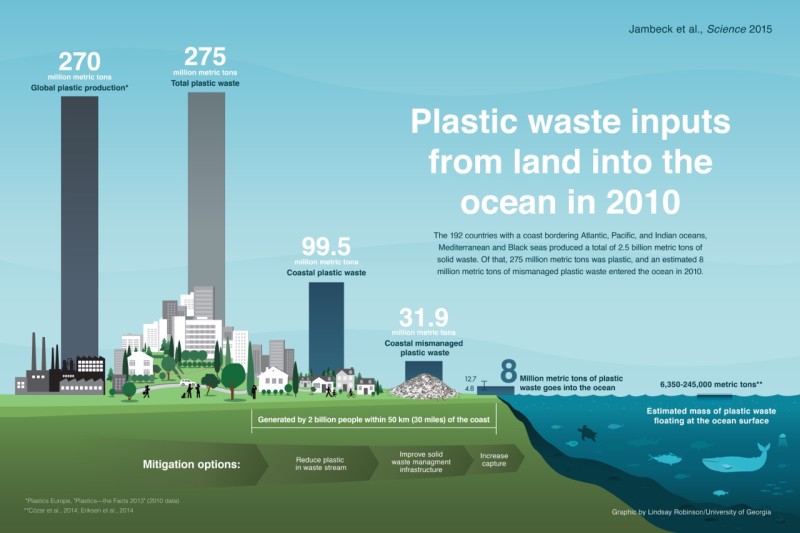Scientific literature first reported plastic pollution in the ocean as early as the 1970s. Over 40 years later no rigorous estimates of the amount and origin of plastic debris entering the marine environment exist – until now. Published in Science, a new study by a NCEAS Working Group provides the first estimate quantifying the input of plastic debris from land into the ocean. Additionally, the study offers a framework for developing ocean-scale solutions to the problem of plastic pollution in marine environments.
The Working Group, Marine debris: Scale and impact of trash in ocean ecosystems research publication, for the first time estimated the amount of mismanaged plastic waste that can potentially enter the ocean as marine debris which is generated annually by populations living within 50 km of a coast worldwide. Jambeck et al found that in 2010 alone more than 4.8 million metric tons of plastic waste entered the oceans from land, and that figure may be as high as 12.7 million metric tons. That’s one to three orders of magnitude greater than the reported mass of plastic floating in the oceans. If no waste management infrastructure improvements are made, plastic waste entering the marine environment is predicted to increase by an order of magnitude by 2025.
With increased population and increased per capita consumption, waste will continue to grow. Improving waste management infrastructure in developing countries is essential. Subsequently, while these improvements are being developed, it is imperative industrialized countries take immediate action by reducing waste and restricting single-use plastics.
Plastic waste inputs from land into ocean
Jenna R. Jambeck, Roland Geyer, Chris Wilcox, Theodore R. Siegler, Miriam Perryman, Anthony Andrady, Ramani Narayan, Kara Lavender Law
Science, February, 2015, DOI: 10.1126/science.1260352

More information
– about this project’s research, participants and publications
– https://www.nceas.ucsb.edu/content/worlds-oceans-clogged-millions-tons-plastic-trash
BBC News Online covers NCEAS Working Group research that was recently published in Science
– First Estimate Quantifies Plastic Waste Inputs from Land into Ocean (February 17, 2015)
KCLU’s Lance Orozco talks with one of the lead researchers from the NCEAS study, Dr. Roland Geyer, about the amount of plastic debris flowing into the ocean from land.
021715.oceanplasticsstudy.mp3
– Ocean Tipping Points: Causes and Consequences
New video features a discussion of the causes and consequences of ocean tipping points by prominent leaders in the environmental community. (Produced by Phil Levin)
This work was supported by the National Center for Ecological Analysis and Synthesis, Ocean Conservancy, University of California, Santa Barbara, and the State of California.
Source
NCEAS, press release, 2015-02.
Supplier
American Chemistry Council Inc. (ACC)
National Center for Ecological Analysis and Synthesis NCEAS
Ocean Conservancy
State of California
The Association for Science Education
University of California, Santa Barbara
University of Georgia
Share
Renewable Carbon News – Daily Newsletter
Subscribe to our daily email newsletter – the world's leading newsletter on renewable materials and chemicals











